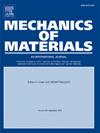A predictive framework for the elastic modulus of recycled carbon-fiber needlepunched nonwoven materials: Integrating process and structure
IF 3.4
3区 材料科学
Q2 MATERIALS SCIENCE, MULTIDISCIPLINARY
引用次数: 0
Abstract
Recycled carbon fibers, destined for landfills or incineration, can be redirected and redeployed for numerous applications, thus reducing the demand for virgin fibers. Needlepunched nonwovens made from recycled carbon fibers opened pathways to second-life opportunities and a broad range of industrial applications, including composite materials. Despite this progress, unraveling the framework that establishes the design rules for predicting the elastic properties of these nonwoven materials – three to four orders of magnitude lower than their constituent fibers – remains a formidable challenge. Herein, we propose a systematic theoretical framework that hinges on the ‘process-structure-property’ relationship, integrating the properties of recycled carbon fibers, the three-dimensional (3D) morphological features of the nonwoven, and the proportion of fiber length present in the thru-thickness direction. The analytical framework devised for the elastic modulus of recycled carbon-fiber (rCF) based needlepunched nonwoven materials extended the ‘Paper Physics’ approach into three dimensions by featuring 3D fiber orientation and fiber length distributions. Quantitative descriptors of the 3D orientation states of two distinct needlepunched nonwovens made from recycled carbon fibers, influenced by process conditions, have been obtained using X-ray micro-computed analysis. A reasonably good agreement between the predicted and experimental elastic modulus values in both the machine and cross-machine directions, coupled with a reduction from the carbon fiber modulus in the range of hundreds of gigapascals to a few tens of megapascals in nonwovens, justifies the robustness of the predictive model.

再生碳纤维针刺非织造材料弹性模量的预测框架:整合工艺与结构
原本要被填埋或焚烧的再生碳纤维可以重新定向和重新部署,用于多种用途,从而减少了对原生纤维的需求。由回收碳纤维制成的针刺非织造布开辟了通往二次生命机会和广泛工业应用的道路,包括复合材料。尽管取得了这样的进展,但要解开建立预测这些非织造材料弹性性能的设计规则的框架——弹性性能比其组成纤维低三到四个数量级——仍然是一个艰巨的挑战。在此,我们提出了一个系统的理论框架,以“工艺-结构-性能”的关系为基础,综合了再生碳纤维的性能、非织造布的三维(3D)形态特征以及纤维长度在穿过-厚度方向上的比例。为基于再生碳纤维(rCF)的针刺非织造材料的弹性模量设计的分析框架通过具有3D纤维方向和纤维长度分布将“纸张物理”方法扩展到三维空间。利用x射线微计算机分析,获得了两种不同的再生碳纤维针刺非织造布在不同工艺条件下的三维取向状态的定量描述符。在机器和跨机器方向上,预测的弹性模量值与实验的弹性模量值相当吻合,再加上非织造布的碳纤维模量从数百千兆帕斯卡减少到几十兆帕斯卡,证明了预测模型的鲁棒性。
本文章由计算机程序翻译,如有差异,请以英文原文为准。
求助全文
约1分钟内获得全文
求助全文
来源期刊

Mechanics of Materials
工程技术-材料科学:综合
CiteScore
7.60
自引率
5.10%
发文量
243
审稿时长
46 days
期刊介绍:
Mechanics of Materials is a forum for original scientific research on the flow, fracture, and general constitutive behavior of geophysical, geotechnical and technological materials, with balanced coverage of advanced technological and natural materials, with balanced coverage of theoretical, experimental, and field investigations. Of special concern are macroscopic predictions based on microscopic models, identification of microscopic structures from limited overall macroscopic data, experimental and field results that lead to fundamental understanding of the behavior of materials, and coordinated experimental and analytical investigations that culminate in theories with predictive quality.
 求助内容:
求助内容: 应助结果提醒方式:
应助结果提醒方式:


